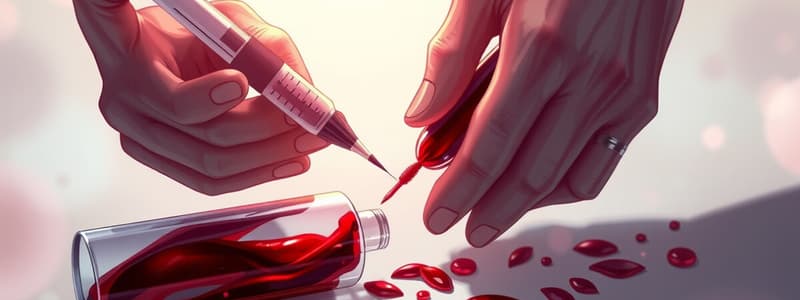Podcast
Questions and Answers
What is the primary function of red blood cells (RBCs)?
What is the primary function of red blood cells (RBCs)?
- To stimulate blood clotting
- To defend the body against infections
- To help regulate body temperature
- To transport oxygen (correct)
What is the main component of plasma?
What is the main component of plasma?
- Lipids
- Fibrinogen
- Water (correct)
- Carbohydrates
Why is correct patient identification critical in phlebotomy?
Why is correct patient identification critical in phlebotomy?
- To accurately record patient medical history
- To ensure the blood sample is properly collected (correct)
- To comply with laboratory safety guidelines
- To prevent blood contamination
What is the distinction between plasma and serum?
What is the distinction between plasma and serum?
What precaution must be taken by phlebotomists to protect against infections?
What precaution must be taken by phlebotomists to protect against infections?
What is the purpose of cleaning the puncture site with 70% alcohol before blood collection?
What is the purpose of cleaning the puncture site with 70% alcohol before blood collection?
Why should Betadine not be used to clean the phlebotomy area?
Why should Betadine not be used to clean the phlebotomy area?
What should be done with needles after use in phlebotomy?
What should be done with needles after use in phlebotomy?
In which situation is skin puncture preferred for blood collection?
In which situation is skin puncture preferred for blood collection?
Which item is typically NOT used during a skin puncture for blood collection?
Which item is typically NOT used during a skin puncture for blood collection?
Flashcards are hidden until you start studying
Study Notes
Blood Composition
- Blood consists of approximately 45% formed elements: red blood cells (RBCs), white blood cells (WBCs), and platelets.
- RBCs contain hemoglobin that binds oxygen, while WBCs protect against infections.
- Platelets are primarily involved in stopping bleeding.
- The liquid portion of blood is around 55%, with about 90% as water and 10% as proteins (albumin, globulin, fibrinogen), carbohydrates, vitamins, hormones, enzymes, lipids, and salts.
- Blood without anticoagulants is called serum post-coagulation and lacks fibrinogen.
Phlebotomy Techniques
- Proper patient identification is crucial; hospital patients identified via wristbands, outpatients via verbal confirmation and requisition slips.
- Blood specimens require labeling with the patient's full name, hospital ID number, location, time, date, and phlebotomist's initials for accurate tracking.
- Gloves must be worn at all times to prevent bloodborne infections (HBV/HIV) and hands should be washed between patients.
- The puncture site should be cleaned with 70% alcohol; Betadine is not recommended due to potential test interference.
- Sharp instruments and needles must be disposed of in puncture-resistant biohazard containers; recapping is prohibited.
Skin Puncture
- Skin puncture, or microsampling, is often used in specific patient categories:
- Infants under 6 months due to limited blood volume and risks associated with venipuncture.
- Young children when only small blood samples are needed, typically collected from the finger.
- Adults with poor vein visibility or those receiving IV infusions may also require finger punctures.
Required Reagents & Equipment
- 70% alcohol for cleaning the puncture site.
- Sterile gauze for pressure and cleaning.
- Skin puncture device (sterile blood lancet) for drawing blood.
- Capillary tubes and Microtainers for specimen collection.
Studying That Suits You
Use AI to generate personalized quizzes and flashcards to suit your learning preferences.




